Comic BooK Confidential: Boo 52!
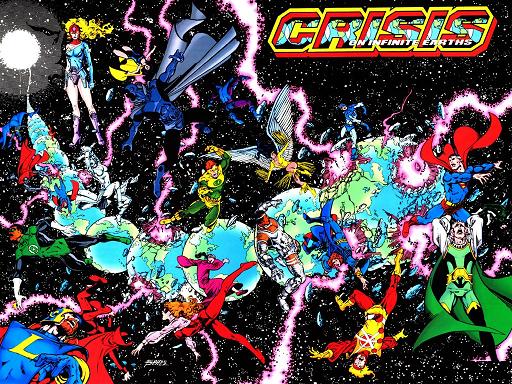
The wrap around artwork for the fist issue of the comic book that started it all - Crisis on Infinite Earths.
Continuity. It may seem like a big word but to the publishers of DC Comics it has exactly four letters. Continuity seems to be a constant thorn in their side. It is a concept that they never seem to be able to decide whether to embrace, ignore, or destroy. It really only has as much impact as they choose to empower it with but it could prove to be their demise. If DC Comics perishes any time soon, the cause of death will be continuity.
The root of the problem can be traced to 1985, shortly after the comic book giant DC celebrated its 50th anniversary. Those first five decades had seen the start and finish of the Golden Age of comic books (1934-1956) and the Silver Age, which had followed immediately thereafter, was drawing to a close. To jump start what would become known as the Bronze Age in 1985, DC decided to do some much needed house keeping and make their comics more attractive to new readers. One unique trait in DC storytelling was their concept of multiple Earths. This had begun shortly after the start of the Silver Age when they reconciled the twenty-years of continuity that had preceded it as all taking place on a separate world they dubbed Earth-2. The current stories were designated to be taking place on Earth-1, so everything was neat and tidy and fairly easy to follow.
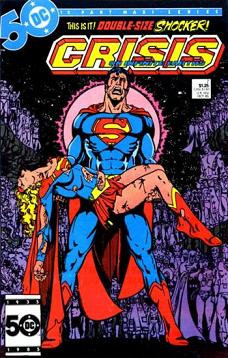
One of the most dramatic events of the Crisis on Infinite Earths was the death of Supergirl but it didn't last.
The multiple Earths concept worked great at first and even allowed writers to go back and create new stories for the characters of the older Earth or have them cross over and interact with their counterparts in the new one. It was, if you will pardon the pun, the best of both worlds. This helped DC create some of the best stories to come out of the 1960s and kept old and new fans alike happy. Unfortunately, they couldn’t leave well enough alone and in 1964 they created Earth-3, a world devoid of heroes and overrun with supervillians. This would be followed by many other Earths, usually appearing when DC acquired a rival comic book publisher and needed a convenient way to roll these characters into DC storytelling continuity. This process continued unchecked for over twenty-five years until the seemingly infinite number of alternate Earths became so unwieldy they were deemed a crisis.
So it was that in 1985, DC decided to dedicate one entire year of publishing to undoing the precedents of the past fifty years and restarting their history with all of their characters existing on a single world. The global twelve issue series that was the backbone of this event was called, appropriately enough, Crisis on Infinite Earths and it managed to feature at least background cameos from almost every superhero character DC owned the rights to as well as a huge roster of villains and supporting characters. The event touched every comic book DC published at the time and when the dust settled the multiverse that had existed for decades was replaced by a universe containing a single Earth. Crisis on Infinite Earths was a terrific story that was well executed and had an acceptable outcome with a great deal of promise. The only problem was that in the hands of the powers that be at DC Comics, the new universe was doomed from the start.
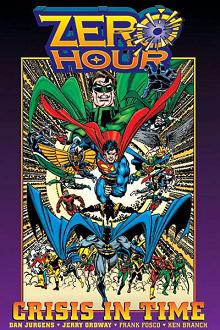
The trade paperback collection of Zero Hour: Crisis in Time.
After literally putting all of their eggs, or Earths, in one basket, DC spent the next ten years trying to reconcile what they had done. As could be expected with any storyline of this magnitude, Crisis on Infinite Earths had its fare share of loose ends. Some characters, like Power Girl who was originally the Earth-2 version of Supergirl, survived the crisis but were left without a viable origin since the Krypton of her universe now had never existed. Others, like the Justice Society of America who were irrevocably linked to historical events like World War II, now found themselves dealing with age issues that had always been conveniently glossed over in the past. Various writers did their best to explain these discrepancies and entire comic book series like Secret Origins and All Star Squadron were revamped and dedicated to cleaning up the resulting messes. Other comic books like Young All Stars, were created for the sole purpose of explaining how the new universe had come to be, in this case filling in the historical gaps left by the disappearance of many Golden Age heroes like the original Superman, Batman, and Wonder Woman. A large portion of these fixes never worked and were ignored or repaired again a short time later as the continuity crisis began to rear its ugly head.
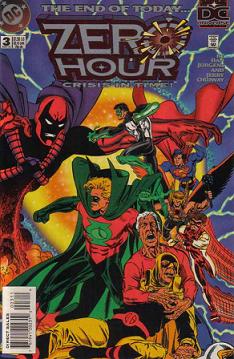
In an effort to keep things "epic" the Justice society of America was delt a tragic blow in Zero Hour.
At the conclusion of Crisis on Infinite Earths, the majority of the remaining characters in the DC Universe were said to no longer remember the multiple Earths that had once existed prior to the remaining ones being merged into a single world. After almost ten years of trying to clean up all the individual problems this created, DC tried to reboot the whole mess with another crisis called Zero Hour: Crisis in Time. This literally saw the universe restarted by a new big bang at the dawn of its creation. This event caused subtle shifts in the timeline that DC used as an excuse to sweep some of those pesky continuity problems under the four color carpet, like merging all of the different Hawkman characters into a single entity. Realizing that Zero Hour would not be the end to their problems they had once thought Crisis on Infinite Earths might be, DC also created a back up plan called Hypertime that could account for further continuity mishaps. It must have seemed like a great idea at the time to rewrite history from day one all the way up to the present and smooth over all of the rough spots from the previous decade but like a cheap ball of yarn, things started unraveling almost immediately.
For another decade DC trotted out a few minor crossover series that all threatened to “change the DC Universe forever” but nothing really lasted for long. The events of Zero Hour were largely undone and, whether or not the characters were supposed to remember this crisis or not, very little was ever mentioned about it again. As the continuity problems began to become as unwieldy as ever, DC began to do some reality altering of its own by dropping hints that the Crisis on Infinite Earths had only been the beginning of a larger story arc that was destined to be continued. In an effort to milk this for all it was worth, several mini-series and a one shot publication appeared in advance to help build up interest in this supposed new epic event.
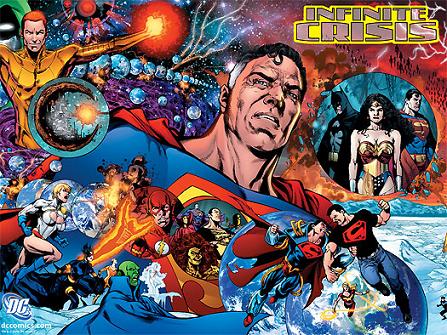
The artwork for Infinite Crisis made the story look better than it really was.
2005 was the year of the rather unoriginally titled miniseries Infinite Crisis, which was almost immediately dubbed Infinite Crapfest by the fans. Using a few convenient loose ends from the Crisis on Infinite Earths, the Golden Age Superman, his wife Lois Lane, a Superboy from the obscure Earth-Prime, and Alexander Luthor, the sole hero of Earth-3 escape from limbo to supposedly prevent an even greater crisis about to destroy the mainstream universe.
The convoluted plot of Infinite Crisis has the preceding twenty years of problems supposedly being the result of the new universe being imperfect. The Golden Age Superman thinks that he can alter the new Earth into a version of his home, Earth-2, and correct these problems while saving his dying wife at the same time. In reality this turns out to be a ploy by the now insane Alexander Luther to create a perfect world by restoring and then re-merging many of the alternate Earths. The displaced Superboy-Prime has similarly gone crackers during his forced exile and believes that Luthor’s perfect world will be a recreation of his Earth-Prime where he can once again be a hero.
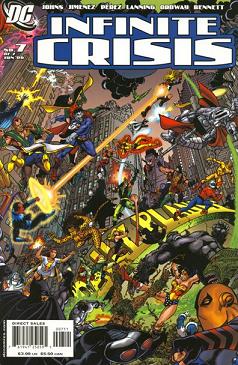
This Crisis wasn't nearly as Infinite as it should have been.
Aside from being a weak story in general and an extremely inferior follow up to Crisis on Infinite Earths, Infinite Crisis is riddled with senseless violence and character deaths intended to make it more dramatic but ultimately seeming superfluous. After seven dedicated issues of the series and numerous cross-overs into other books, this crisis ends with a now homicidally psychotic Superboy-Prime killing the Golden Age Superman before being finally subdued and imprisoned by the Green Lantern Corps in a move that just screamed “this will never last” at the top of its lungs. At least Alexander Luthor was killed by his Earth-1 counterpart and the Joker, who had largely been absent from the whole event. The continuity problems of the previous ten years were chalked up to the ridiculous plot device of Superboy-Prime creating shockwaves throughout time by punching the walls of crystals he used to spy on the universe from the pocket dimension he had been trapped in. Worst of all, DC unraveled the final thread of the Crisis on Infinite Earths by creating 52 new universes which were revealed a short time later.
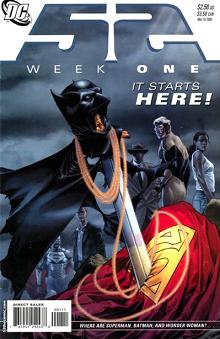
52 - if only it all really had ended here!
After Infinite Crisis, DC seemed to be churning out epic events faster than the public could read them. The entire Dc Universe was immediately shoved one year into the future to help the writers avoid the continuity plot holes that now loomed like craters and the missing time was explained in an ironically year long weekly series called 52. 52 was something of a hodge podge comprised of self contained stories, running themes, revised secret origins, jumping off points for other books, and even tie-ins to other epic events like World War III that were starting to seem mundane. 52 petered out into several mini-series of Aftermath books and a few other titles under the banner of Countdown that were supposed to lead into even bigger things. It took DC Comics 20 years to get around to undoing the events of Crisis on Infinite Earths but this event was now just the beginning. Readers were still busy hurling profanities at the middle installment, Infinite Crisis, when the, at least aptly if again unoriginally named, Final Crisis was announced.
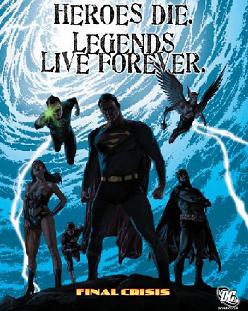
One of the DC house ads heralding the coming of the supposed Final Crisis.
DC followed the 52 issues that were needed to explain the impact of Infinite Crisis with another 52 issues, a one shot called DC Universe #0 and then fifty-one issues to Countdown to Final Crisis. This supposed most epic of epic events concerns the dying evil New God Darkseid attempting to claim the Earth for himself and his followers while finding a way to prolong his existence. Reviving an old chestnut that had been a running plot device in the New Gods titles since the 1970’s, Darkseid releases an electronic virus called the anti-life equation and uses it to control almost all of the world’s population. With the majority of the New Gods dead and the Earth, including superheroes and supervillians, under Darkseid’s power, only a ragtag band of characters are left to oppose him. The rather unsatisfying conclusion to this major event has a cure for the virus being discovered that was left on Earth at the dawn of time along with the anti-life equation. Batman kills Darkseid with a specially designed bullet and dies in the process as the villain’s essence drags all of reality out of existence with him. At the last possible moment, Superman manages to complete construction on a wish granting device called the Miracle Machine and wish everything back to the way it was. Too bad he didn’t have the foresight to wish everything back to the way it was before the Crisis on Infinite Earths and undo the mess that had been spiraling out of control since then! This was just a little too convenient for what was supposed to be the culmination of a twenty-three year long running storyline. Ultimately, the most startling aspect of Final Crisis was the sheer number of cross-over and tie-in books DC managed to get published in conjunction with it.
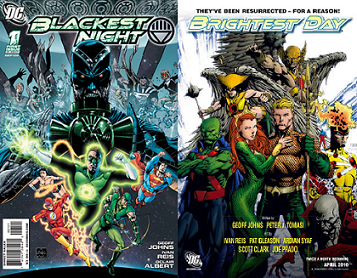
The Blackest Night followed by the Brightest Day.
Needless to say, Batman wasn’t really dead just lost in time and his recovery became one of several post Final Crisis storylines that fueled additional mini-series. The death of major characters in the DC Universe got to the point that they held so little impact, since no one believed they would really last long, that an entire mega event was dedicated to supposedly leveling the playing field and keeping the deceased dead from that point forward. Blackest Night appeared right on the heels of Final Crisis and DC used it and its immediate follow-up, Brightest Day, to revive anyone and everyone they wanted to and then close that plot contrivance for good if any readers were actually gullible enough to believe that. DC undid many of the dramatic touches that had once made their stories meaningful but were now almost comically commonplace. Lack of continuity now wasn’t just being ignored or down-played, it seemed to be flaunted as some type of benefit.
By the end of the Brightest Day series in early 2011, most of DC Comics’ readers were sick of the never ending stream of crises, mega series, and reality altering events that the publisher had been doling out almost nonstop for close to a decade. As each new startling, life changing series was played out, sales declined further and further. Rather than recognizing this for what it was, DC blamed it on new readers feeling alienated by the history that existed in their comics and not being willing to invest the time required in catching up. Loyal readers who had been subscribing for years were marginalized at best and insulted at worst and it was all over in a Flash!
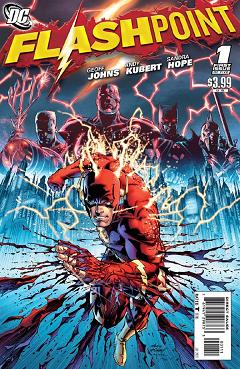
Flashpoint was a fairly good story on its own but a poor excuse for things to come.
The Barry Allen version of the Flash was originally created in 1956 and is considered one of, if not the very first, superheroes of the Silver Age of DC comic books. After an extremely impressive run just shy of thirty years, the Flash was given one of the most noble send offs in comic book history when he sacrificed himself to the speed force in order to warn his fellow heroes of the impending Crisis on Infinite Earths in 1985. His return to life in Final Crisis was seen by most readers as the last vestige of the previous crisis having any meaning and was a major contributor for a downturn in sales for DC. In 2011, he was once again used as the central character for another mega story arc that burned out readers had a hard time getting excited about.
On the surface, Flashpoint is an enjoyable, if unoriginal, little story. The concept of time travel into the past and its impact on the present day had been explored countless times in comic books over the years. In this take, the Flash wakes up one day to discover his world completely different than the way he remembers it from the day before. In this much darker reality, there are a far smaller number of superheroes and two factions of them, one lead by Aquaman and one lead by Wonder Woman, are in the middle of a bloody war to control the planet that may well end with everyone dead. Flash seeks out the help of the smartest person he knows, Batman, only to find that caped crusader of this timeline is Bruce Wayne’s father Thomas, who became the dark knight after watching his son die in a robbery. He eventually discovers that the coronal shift was caused by his altering time by going back to prevent his mother’s death at the hands of his archenemy Professor Zoom, the Reverse Flash.
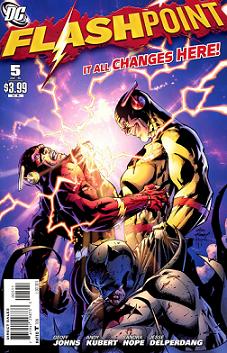
Two Flashes enter, one Flash leaves!
At the conclusion of Flashpoint, Thomas Wayne Batman kills Professor Zoom and Barry Allen once again goes back in time to prevent himself from altering it. As the timeline is realigning itself, Allen sees three different realities, the regular DC Universe plus their tangent comic lines of Wildstorm and Vertigo all existing simultaneously. A mysterious presence tells him that these realities were split to weaken them and they must now be merged back into one to stop yet another impending crisis. When Barry Allen awakens from this nightmare, just shortly before the reader awakens from their own, he has returned to his own timeline, which is seemingly back to normal, but retains his memories of a world that might have been.
It was bad enough that this otherwise innocuous little story was just a lead in for the next big series DC had up its sleeve to drain Fanboy wallets, but they also used it to cram their other comic book lines into the main one and further decimate what fleeting continuity remained. The real sucker punch came immediately afterwards though with a move more astute comic book readers had been anticipating. DC had announced that several of its titles would be put on hold during Flashpoint to supposedly make room for the additional books related to it. Rumors began to circulate that this might become permanent and, sure enough, in September of 2011 DC revamped its entire comic book roster. The company line was that the time alterations of Flashpoint had erased the entire continuity problem as well as a significant portion of their characters and those books that did remain would now start over from square one. Falshpoint had become Flushpoint and the whole of DC Comics was headed down the tubes.
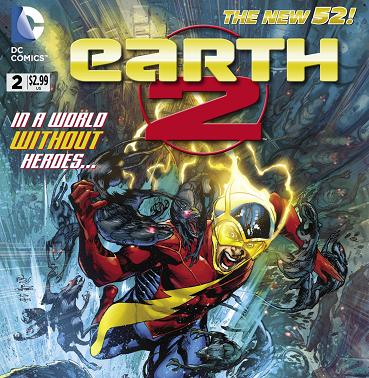
A lame looking new Flash on a lame looking new Earth-2. If this is your New 52 DC, you can keep it!
Once again DC caters to the new generation of readers who cannot appreciate the rich and enjoyable history continuity provides, while penalizing long time readers for their loyalty. The revived but finite multiple Earths concept, which had been gathering dust since its reintroduction, may finally see implementation. The Justice Society of America, one of the world’s first superhero teams, was one of the many casualties of this cleanup who could have been returned to their own Earth and actually benefited from this purge. Sadly, they weren’t even afforded that small dignity and it now appears that the group fans have enjoyed reading about for over sixty years no longer exists and, per current DC policy, never did. In their place are a re-imagined group of heroes on a restored alternate Earth, one of the “New 52″, who now get to start all over again as pale shadows of a once great team.
If DC Comics isn’t careful, the next crisis they see may be one of lost readers and plummeting sales figures, a reality that started around the end of 2011 when the media giant fell into second place behind chief rival Marvel for the first time in over a year. This was also shortly after their big house cleaning move which gave readers just enough time to cancel what few subscriptions they still had remaining once the dust cleared and pass on picking up any new ones. After years of lackluster, pointless huge crossover story arcs and multiple mini-series that ultimately amounted to very little or were quickly negated, even the most diehard DC fans found themselves weary.
In the twenty-seven years since this vicious cycle of breaking down, building up, and breaking down again began with the Crisis on Infinite Earths, DC Comics seems to have learned very little. They have become the little boy who cried crisis too many times and now fans are indifferent to their promises of epic storytelling and world changing events. With all the countdown and aftermath themed peripheral titles that go with each new major story arc, it now seems like the crises never end. Unless DC comes up with a reality they can stick to and some quality stories to lure back jaded readers, they could very easily find themselves without an Earth left to stand on.
